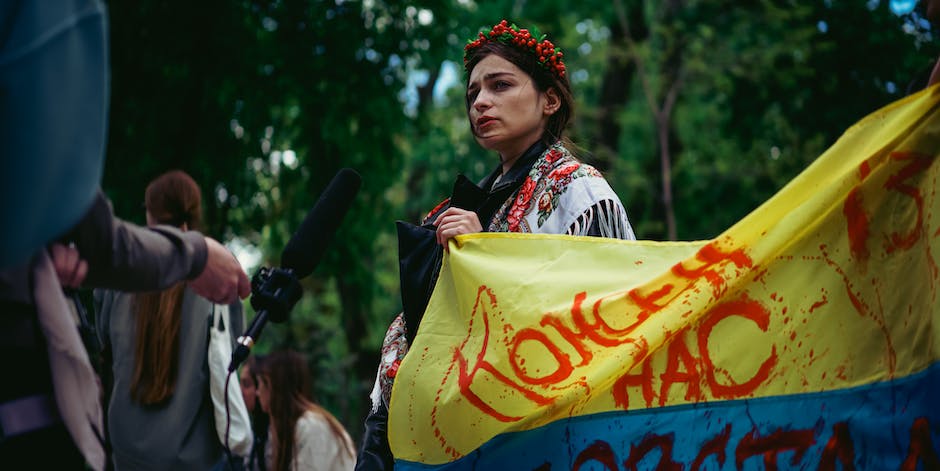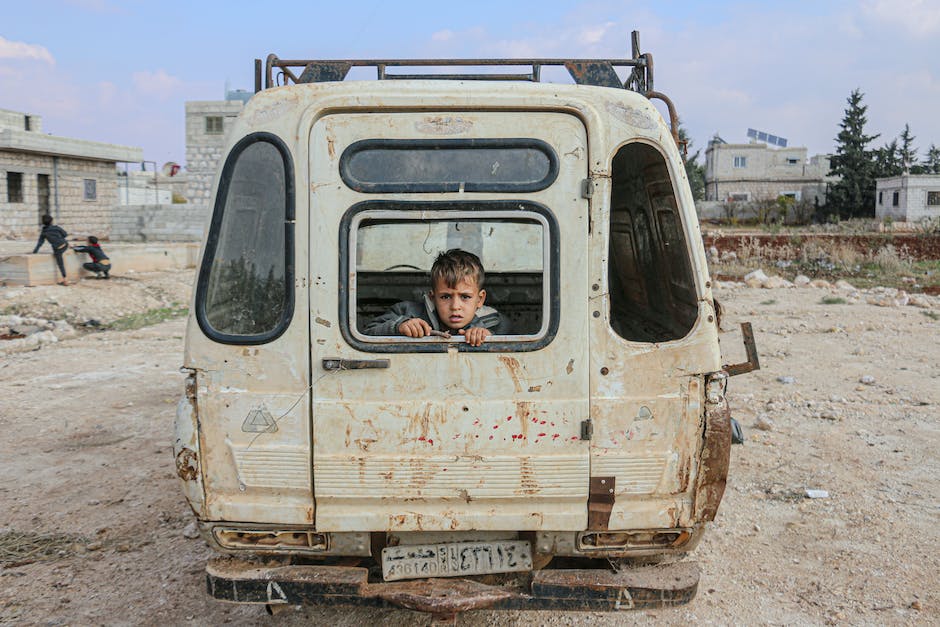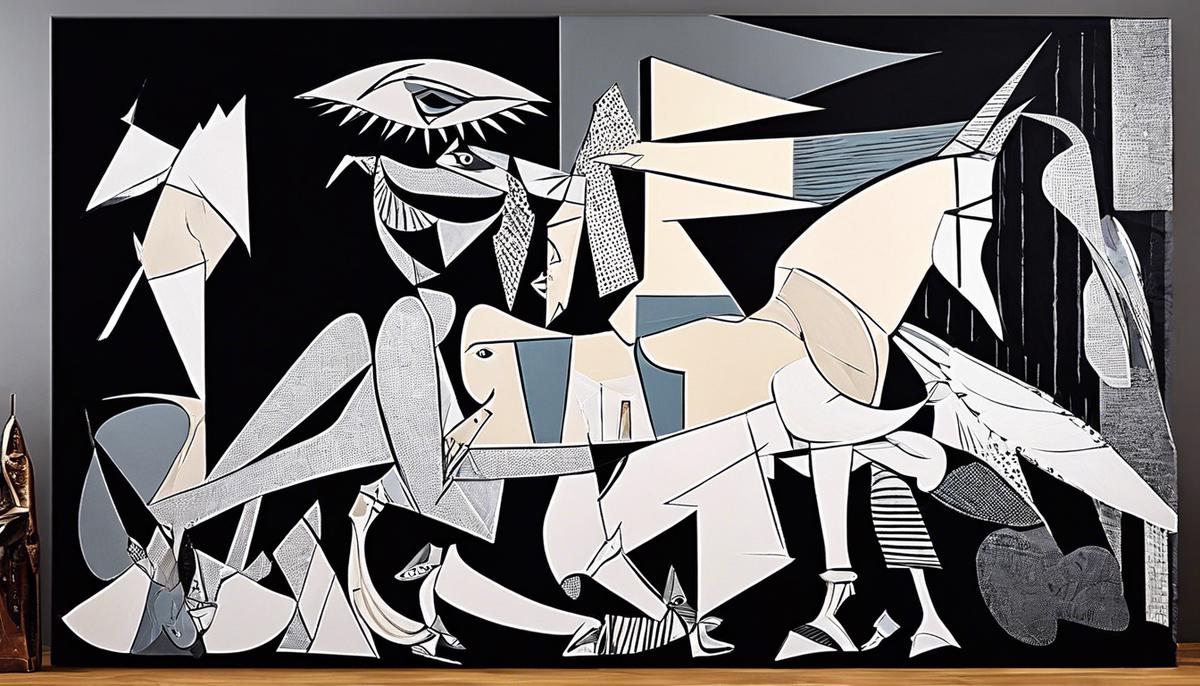At the epicentre of Pablo Picasso’s oeuvre stands ‘Guernica’, a potent tapestry of pain sown into the fabric of modern art, unravelling across the canvas with silent screams that pierce the annals of history. This monochromatic masterpiece, born from the ashes of a devastated Basque town, articulates the turmoil of the Spanish Civil War and reverberates the cacophony of havoc wreaked on innocent lives. Picasso’s technical prowess not only captures the zeitgeist of 1930s Spain but also heralds an audacious marriage of form and function, as his adroit hands weave together Cubist influences and profound symbolism with unerring precision. The canvas becomes a battleground where each stroke, each shade and shape, are deliberate choices by the artist, serving as a lodestar to navigate the complex historical and emotional landscape of a country ravaged by conflict.
Historical Context of Guernica
Unravelling the Historical Context Behind Picasso’s Guernica
Pablo Picasso’s 1937 masterpiece “Guernica” stands as a profound critique of wartime atrocities, embodying a visceral response to the bombing of the Basque town during the Spanish Civil War. The historical backdrop informs not only the content but also the techniques employed by Picasso, making it a pivotal piece in the canon of 20th-century art.
To appreciate the historical context of “Guernica,” one must first recognise the zeitgeist of interwar Europe. The Spanish Civil War (1936-1939) acted as a prologue to the global conflict soon to ensue, with ideological clashes between fascism and communism. It is in this milieu of rising totalitarianism that Picasso’s work is anchored.
The bombing of Guernica on 26 April 1937, carried out by Nazi Germany’s Luftwaffe and Italy’s Fascist Aviazione Legionaria at the behest of the Spanish Nationalists, resulted in civilian casualties and widespread destruction, provoking international outrage. Picasso, who had already plied his trade in pushing artistic boundaries, was emotionally stirred by such devastation, and it was this event that precipitated the painting of “Guernica.”
The canvas itself is monumental, yet it is the technique and style that truly articulate the historical narrative. Picasso chose a stark monochromatic palette, almost journalistic in its black and white tones, reminiscent of the grim photographs of the event circulating at the time. This colour scheme eschews the glorification of war, instead of laying bare the brutality and sorrow of the incident.
Picasso employs cubism, a style he co-founded, to fragment the narrative, placing angular shapes and broken geometric figures side by side, reflecting both the physical shattering of the town and the disintegration of societal norms in the face of barbarism. This technique, with its inherent dislocation of perspective, mirrors the chaos and disorientation experienced by the victims of the bombing.
Further, elements of surrealism are woven into the tapestry of “Guernica.” The bull and the horse, staple figures in Spanish culture, appear tormented and distorted, symbolising the perversion of Spain’s cultural identity under the shadow of war. The inclusion of a light bulb (“bombilla“), styled like a malevolent sun, represents the destructiveness of modern technology, a poignant reminder of the incendiary power that rained down upon Guernica.
The techniques Picasso adopts serve to transcend conventional narrative forms; rather than depicting the event in a literal sense, he invites a visceral and emotional engagement. This engagement is not sought through sensationalism, but through an unveiling of the psychological and cultural trauma inflicted by warfare.
In conclusion, “Guernica” is not merely a painting; it is an historical document rendered in abstract terms. It captures the fractured essence of a moment in time, employing artistic techniques that both reflect and dissect the cataclysmic impact of the Guernica bombing. Picasso’s work thus remains an enduring symbol of anti-war sentiment and an exemplar of art’s capacity to communicate historical truth through the language of abstraction.

Photo by joshuanewton on Unsplash
Symbolism and Its Technical Manifestation
In considering the symbolically charged opus “Guernica” by Pablo Picasso, one must delve beyond the surface into the myriad of metaphorical constituents meticulously woven into its fabric. The work stands not merely as a response to a specific event but morphs into a tableau of universal human anguish in the face of atrocity.
At the fore, the beleaguered figures are not simple representations of people and animals but rather allegories of suffering and chaos. The dismembered soldier sprawled upon the ground is emblematic of the ultimate sacrifice, the loss of life, as well as the fragmentation of the human spirit amidst violent conflict. The bull, an animal steeped in Spanish cultural iconography, oscillates in interpretation between the brute force of Fascism and the steadfast resilience of the Spanish people.
Meanwhile, the presence of the grieving woman cradling a lifeless child invokes the iconic Christian image of the Pietà, thereby universalizing the sorrow of Guernica to encompass all epochs and geographies, reminding the observer of the perennial nature of maternal grief. Furthermore, some analysts posit that the light bulb blazing over the scene is an ironic twist on the notion of enlightenment—a blinding and destructive force rather than a symbol of intellectual illumination.
Technically, these symbols are represented through a confluence of fragmentation and distortion, hallmarks of Picasso’s Cubist sensibilities. Multiple perspectives and broken geometry serve to disconcert the viewer, amplifying the sensation of pandemonium that war engenders. This technique captures not just the visible tumult but also resonates with the internal disarray experienced by witnesses and victims.
Additionally, the meticulous use of chiaroscuro—strong contrasts between light and dark—within the monochromatic scheme lays bare a stark reality. It conjures a sensation of harsh revelation, as though each illuminated figure and object is inescapable in its truth. The absence of colour, which could impart a particular bias or emotional undertone, allows the viewer to confront the raw and universal truth of suffering.
The conflation of technical mastery and potent symbolic elements in Picasso’s “Guernica” emboldens its status as a testament to the tragedies of war and the indomitable quest for peace. It stands as a testament to the transformative power of art to encapsulate complex human experiences and emotions. In its echoes, the painting continues to speak volumes of the silent witnesses of history and the timeless struggle against the scourge of violence.

Cubist Influence and Technique
Cubism’s Impact on the Innovative Techniques in Picasso’s “Guernica”: A Deeper Analysis
In the realm of modern art, Cubism emerged as a revolutionary movement, radically altering the traditional perspectives on visual representation. Its inception is emblematic of an urge to deconstruct reality and furnish it anew through the artist’s analytical vision. The implications of such a transformation in technique are profoundly evident in Pablo Picasso’s oeuvre, particularly in his politically charged masterpiece “Guernica.”
Cubism distinguishes itself through an emphasis on the flattened two-dimensional plane, fracturing objects into geometric forms and realigning them on the canvas to present multiple viewpoints simultaneously. This approach not only challenges the viewer’s perception but also invites a more interactive scrutiny of the depicted scenes—serving as an ideal conduit for the complex narrative in “Guernica.”
Employing these Cubist techniques, Picasso disassembles and reassembles the harrowing scenes within “Guernica” to evoke the sense of chaos and fragmentation wrought by the bombing. The dismembered limbs, severed heads, and agonized expressions are ensnared in a network of sharp, anguished lines, crafting a tableau that transcends simple representation. This method of representation is particularly evident in the disjointed body of the soldier found at the painting’s lower edge and the tormented horse that commands the centre, their forms splintered and then coalesced into an arresting symbol of devastation.
The presence of iconic motifs, such as the bull and the horse, further exemplifies the application of Cubist logic, as Picasso breaks these figures into facets that, while being disjointed, preserve their emblematic force. These animals — one synonymous with Spain and the other with the calamity of war — are reconstructed to represent concepts rather than to replicate their physical likeness faithfully. Through this symbolic narrative, the viewer is ushered through a myriad of interpretations, resting neither on the literal nor the figurative but in the liminal space of allegorical significance.
Furthermore, the daring use of chiaroscuro in “Guernica” borrows heavily from the Cubist affection for dramatic contrasts and interplay of light and shadow. This boldly amplified stylistic technique heightens the visceral emotional response elicited by the artwork. The stark illumination accentuates the urgency and gravity of the scene, directing the viewer’s focus toward the key elements of turmoil within the composition.
The decision to eschew colour, meanwhile, serves to emphasize the grim nature of the narrative. Within Cubism, the experimentation with colour often ventured into realms of abstraction; however, in “Guernica,” the absence of colour serves to strip away any semblance of vibrancy, aligning the painting’s aesthetic with the desolation it depicts. This technique exemplifies a restraint that augments rather than diminishes the work’s emotive potency.
Through the integration of these innovative techniques, “Guernica” stands as a definitive juxtaposition of Cubism’s intellectual construction and the visceral cataclysm of war. It epitomizes the catalytic potency of art, harnessing Cubist elements not merely for their novel visual appeal but as essential vehicles for the communication of a profound human indictment against violence and destruction.
Ultimately, Picasso’s “Guernica” coalesces these myriad Cubist approaches to forge a powerful reflection of the collective human ordeal. The ingenuity in technique becomes the cornerstone of its enduring legacy, captivating the viewer, inciting introspection, and, most crucially, memorializing the indiscriminate horror of war for posterity. In this manner, Cubism bestows upon “Guernica” a timeless and universal relevance, underlining its role not only as an artistic marvel but also as a poignant historical document.

Photo by europeana on Unsplash
Technical Aspects of Composition
Guernica, a masterpiece by Pablo Picasso, rendered in stark black and white, demands an examination of its compositional techniques with the gravity it rightfully deserves. Beyond its documented historical and psychological resonances, the canvas seethes with artistic devices that convey the turmoil and anguish of its subject matter.
One must consider the strategic placement of figures and objects within the tableau. Picasso arranges the tormented forms in a manner that leads the viewer’s eye across the scene of devastation. This compositional technique not only narrates the horrific tale but also invokes an emotional cacophony within the onlooker, simulating the disorientation felt in the midst of warfare’s chaos.
Dynamic tension is a crucial element of the painting’s composition. Forms and figures are captured in mid-motion, such as the horse rearing in pain and the fallen warrior. This kinetic force expressed through static imagery encapsulates the violence of the event, effectively arresting time.
Furthermore, spatial ambiguity plays a significant role in Guernica. Picasso deliberately eschews traditional perspectives and proportions, opting instead for overlapping planes and intersecting lines. This curated disorder disorients the viewer, creating an unsettling sense of instability and dislocation that mirrors the psychological state of those enduring the event.
Additionally, the piece utilizes scale to emphasize certain elements over others. While some figures are inflated in size, conveying monumental suffering, others are diminished, perhaps to represent the helplessness and frailty of individuals against the crushing force of conflict.
The strategic use of lines in Guernica also demands attention. Lines not only define the fragmented bodies and objects but also serve to communicate tension and fracture. Be it the sharp, jagged lines that suggest destruction or the sweeping curves evoking anguish, they guide the emotional tenor of Picasso’s composition.
In tandem with line usage, textural contrasts inject a tactile quality to the piece. The interplay between smooth and rough surfaces within the painting enhances the visual drama of the scene and augments the visceral response of the viewer.
Lastly, space within Guernica is treated as a palpable entity, contributing to the tension and narrative of the artwork. Rather than serving as a mere backdrop, the surrounding space interacts with and engulfs the figures, underscoring the all-consuming nature of war’s destruction.
Through these sophisticated compositional strategies, Picasso masterfully marries form with function, yielding a work that transcends its era and serves as a perennial reminder of the harrowing impact of human strife. Guernica’s labyrinth of techniques not only defines it as an archetype of modernist artistry but also as a profound visual statement on the universal human condition amidst the chaos of conflict.

Guernica’s Legacy and Technical Innovation
Picasso’s “Guernica”: Catalysing Artistic Evolution through Innovative Visual Language
In the annals of art history, Picasso’s magnum opus ‘Guernica’ is often heralded as a paragon of innovative artistry, simultaneously a poignant expression of tragedy and a technical tour de force. The subversive methods employed in this artwork not only redefined the aesthetic of the time but also instituted a set of practices that would ripple through generations of artists, profoundly influencing the trajectory of modern and contemporary art.
The conceptual advancement of space in ‘Guernica’ stands as a pivotal innovation. Picasso dismantles traditional spatial reasoning, allowing the viewer to occupy a shifting vantage point that moves within the piece rather than observing from without. This disavowal of uniform perspective opens a dynamic avenue for artists to explore narrative and emotional expression in non-linear terms, presenting space not as a backdrop but as a character integral to the orchestration of story.
In the pursuit of capturing the viscera of the conflict in ‘Guernica’, Picasso deploys a calculated orchestration of movement through static imagery. The apparent motion present in ‘Guernica’, despite its silent medium, is crafted through a masterful manipulation of form – where lines and shapes within the composition seem to push and pull against one another, suggesting an underlying turmoil and dynamism. This handling of motion reconfigures the stasis expected of paintings and inspires subsequent artists to consider the potential of implied dynamism to infuse narrative tension within their works.
Picasso’s approach to scale within ‘Guernica’ confers particular weight, both visually and metaphorically, to certain elements over others. The enlarged, disfigured horse at the center, the towering, grieving mother – these strategically crafted discrepancies not only reflect an emotional hierarchy but also serve as a precedent for later artists to emphasize thematic elements through deliberate disproportion.
The visual lexicon of ‘Guernica’ extends to the strategic use of lines and texture, serving as a testament to Picasso’s foresight in employing these elements to convey discord and disruption. Stark textural contrasts within the piece create a palpable sense of drama, guiding the eye across a landscape of suffering and eliciting a tactile response from the observer. This employment of textural diversity has since inspired artists to use surface variance as a vehicle for emotional resonance.
Lastly, it may be observed that ‘Guernica’ does not conclude within the confines of its canvas, but intrinsically interacts with its sociopolitical milieu. The tapestry it unfurls is one where form and function coalesce to transcend its era, to become more than simply a painting but a visual declaration of human experience amid conflict – an innovation that heralded the potential of art as a form of solemn testimony and relentless activism.
As such, the innovations brought forth by Picasso through ‘Guernica’ have sown the seeds for a continuous evolution in artistic expression. From its spatial reconfiguration, suggested movement, and exploration of scale, to its poignant utilization of line, texture, and form-function synergy, ‘Guernica’ is a quintessential beacon of inspiration. Its influence on later artistic endeavours extends an invitation for continuous reinterpretation, a multifaceted dialogue between the past and the present, ensuring its place not only within the hallowed echelons of art history but also within the ever-shifting landscape of artistic innovation.

The impact of ‘Guernica’ extends beyond its vast canvas, transcending the boundaries of time and space to ignite conversations, instigate change and inspire generations. Picasso’s fusion of technique and narrative serves not just as a sombre reminder of a grim epoch but also as a testament to the power of visual language. As we cast our gaze upon the raw, disjointed forms and the stark, oppressive monochrome palette, we are confronted with the immutable truth that art, in its most sublime form, is an indelible chronicle of human experience. The legacy of ‘Guernica’ endures, its echoes felt in the chambers of contemporary art, its lessons imparted to aspiring artists, and its clarion call for peace resonating as poignantly today as it did over eight decades ago.






















